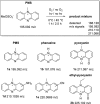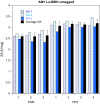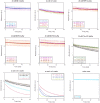Understanding the chemistry of the artificial electron acceptors PES, PMS, DCPIP and Wurster's Blue in methanol dehydrogenase assays
- PMID: 32060650
- PMCID: PMC7082304
- DOI: 10.1007/s00775-020-01752-9
Understanding the chemistry of the artificial electron acceptors PES, PMS, DCPIP and Wurster's Blue in methanol dehydrogenase assays
Abstract
Methanol dehydrogenases (MDH) have recently taken the spotlight with the discovery that a large portion of these enzymes in nature utilize lanthanides in their active sites. The kinetic parameters of these enzymes are determined with a spectrophotometric assay first described by Anthony and Zatman 55 years ago. This artificial assay uses alkylated phenazines, such as phenazine ethosulfate (PES) or phenazine methosulfate (PMS), as primary electron acceptors (EAs) and the electron transfer is further coupled to a dye. However, many groups have reported problems concerning the bleaching of the assay mixture in the absence of MDH and the reproducibility of those assays. Hence, the comparison of kinetic data among MDH enzymes of different species is often cumbersome. Using mass spectrometry, UV-Vis and electron paramagnetic resonance (EPR) spectroscopy, we show that the side reactions of the assay mixture are mainly due to the degradation of assay components. Light-induced demethylation (yielding formaldehyde and phenazine in the case of PMS) or oxidation of PES or PMS as well as a reaction with assay components (ammonia, cyanide) can occur. We suggest here a protocol to avoid these side reactions. Further, we describe a modified synthesis protocol for obtaining the alternative electron acceptor, Wurster's blue (WB), which serves both as EA and dye. The investigation of two lanthanide-dependent methanol dehydrogenases from Methylorubrum extorquens AM1 and Methylacidiphilum fumariolicum SolV with WB, along with handling recommendations, is presented. Lanthanide-dependent methanol dehydrogenases. Understanding the chemistry of artificial electron acceptors and redox dyes can yield more reproducible results.
Keywords: Coupled assay; DCPIP; EPR spectroscopy; Electron acceptors; Enzymatic assay; Methanol dehydrogenase; PES; PMS; UV–Vis spectroscopy; Wurster’s blue.
Conflict of interest statement
All authors declare that they have no conflict of interest.
Figures













Similar articles
-
Studies on electron transfer from methanol dehydrogenase to cytochrome cL, both purified from Hyphomicrobium X.Biochem J. 1989 Jan 1;257(1):87-94. doi: 10.1042/bj2570087. Biochem J. 1989. PMID: 2537627 Free PMC article.
-
Effects of multiple ligand binding on kinetic isotope effects in PQQ-dependent methanol dehydrogenase.Biochemistry. 2003 Apr 8;42(13):3966-78. doi: 10.1021/bi027282v. Biochemistry. 2003. PMID: 12667088
-
Pyrroloquinoline Quinone Ethanol Dehydrogenase in Methylobacterium extorquens AM1 Extends Lanthanide-Dependent Metabolism to Multicarbon Substrates.J Bacteriol. 2016 Oct 21;198(22):3109-3118. doi: 10.1128/JB.00478-16. Print 2016 Nov 15. J Bacteriol. 2016. PMID: 27573017 Free PMC article.
-
The quinoprotein dehydrogenases for methanol and glucose.Arch Biochem Biophys. 2004 Aug 1;428(1):2-9. doi: 10.1016/j.abb.2004.03.038. Arch Biochem Biophys. 2004. PMID: 15234264 Review.
-
The structure and mechanism of methanol dehydrogenase.Biochim Biophys Acta. 2003 Apr 11;1647(1-2):18-23. doi: 10.1016/s1570-9639(03)00042-6. Biochim Biophys Acta. 2003. PMID: 12686102 Review.
Cited by
-
Structural mechanism of a dual-functional enzyme DgpA/B/C as both a C-glycoside cleaving enzyme and an O- to C-glycoside isomerase.Acta Pharm Sin B. 2023 Jan;13(1):246-255. doi: 10.1016/j.apsb.2022.05.022. Epub 2022 May 25. Acta Pharm Sin B. 2023. PMID: 36815035 Free PMC article.
-
Reactive oxygen species drive foraging decisions in Caenorhabditis elegans.Redox Biol. 2023 Nov;67:102934. doi: 10.1016/j.redox.2023.102934. Epub 2023 Oct 13. Redox Biol. 2023. PMID: 37864874 Free PMC article.
-
Spectroscopic and in vitro Investigations of Fe2+ /α-Ketoglutarate-Dependent Enzymes Involved in Nucleic Acid Repair and Modification.Chembiochem. 2022 Jun 3;23(11):e202100605. doi: 10.1002/cbic.202100605. Epub 2022 Feb 15. Chembiochem. 2022. PMID: 35040547 Free PMC article. Review.
-
Deciphering the role of recurrent FAD-dependent enzymes in bacterial phosphonate catabolism.iScience. 2023 Oct 4;26(11):108108. doi: 10.1016/j.isci.2023.108108. eCollection 2023 Nov 17. iScience. 2023. PMID: 37876809 Free PMC article.
-
Photoactivation of Chemotherapeutic Agents with Cerenkov Radiation for Chemo-Photodynamic Therapy.ACS Omega. 2022 Jun 30;7(27):23591-23604. doi: 10.1021/acsomega.2c02153. eCollection 2022 Jul 12. ACS Omega. 2022. PMID: 35847323 Free PMC article.
References
Publication types
MeSH terms
Substances
Supplementary concepts
LinkOut - more resources
Full Text Sources

